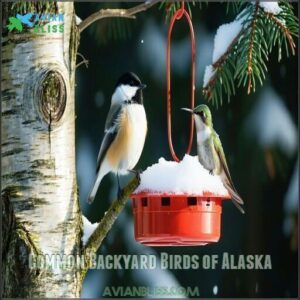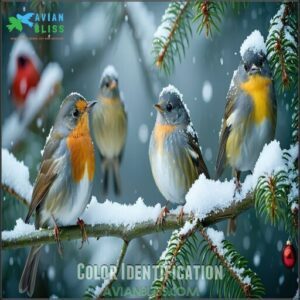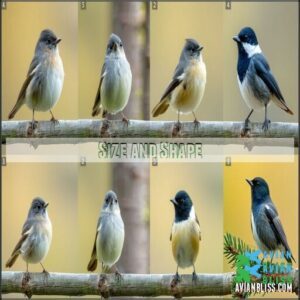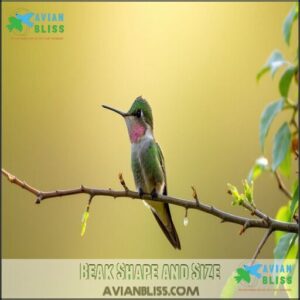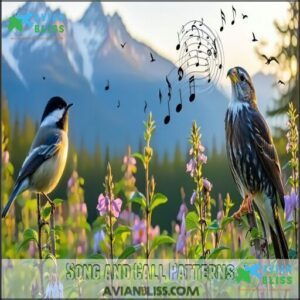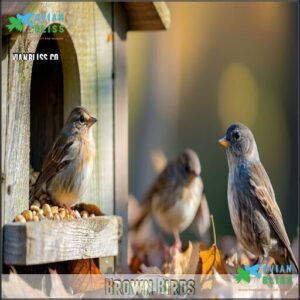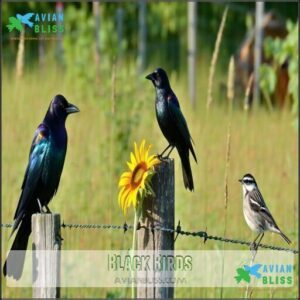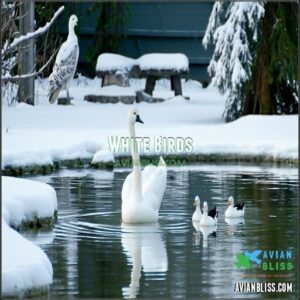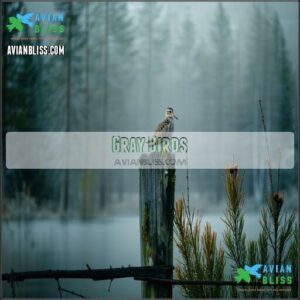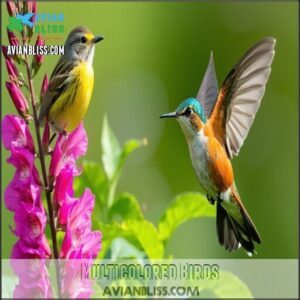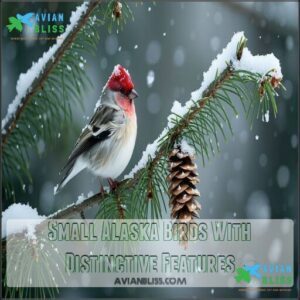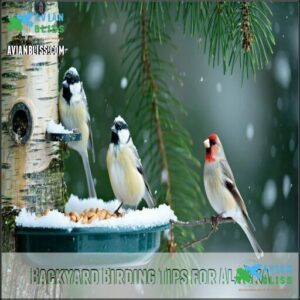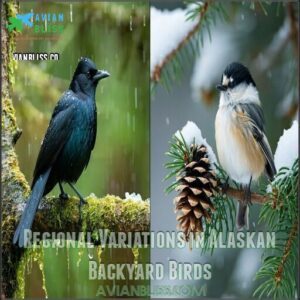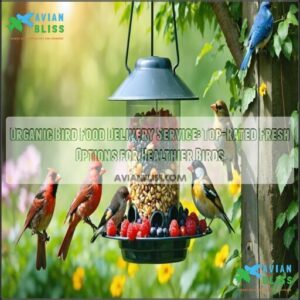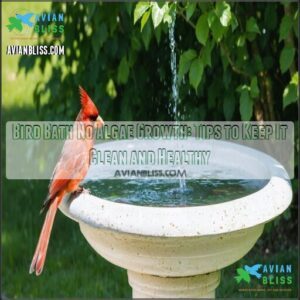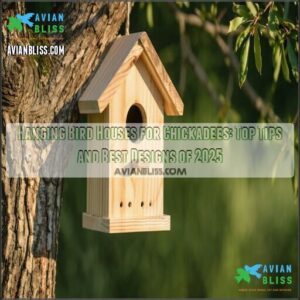This site is supported by our readers. We may earn a commission, at no cost to you, if you purchase through links.
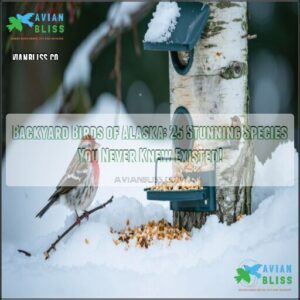 You’ll find Alaska’s backyards teeming with remarkable birds year-round.
You’ll find Alaska’s backyards teeming with remarkable birds year-round.
Black-capped Chickadees and Steller’s Jays brave the winter months, while Rufous Hummingbirds and American Robins arrive in spring.
The Dark-eyed Junco, like a tiny hooded ninja, hops beneath your feeders while Pine Grosbeaks add splashes of rosy red to snowy landscapes.
Many backyard birds of Alaska have adapted to extreme conditions—the Common Redpoll can forage in temperatures reaching -40°F.
Your feeder might also attract Northwestern Crows, Varied Thrushes, and if you’re lucky, the elusive Boreal Chickadee with its distinctive brown cap and raspy call, making it a unique sighting in the Alaskan backyard birds scene.
Table Of Contents
- Key Takeaways
- Common Backyard Birds of Alaska
- Identifying Alaska Birds
- Alaska Bird Species by Color
- Small Alaska Birds With Distinctive Features
- Birds Found in Alaskan Backyards by Season
- Attracting Birds to Your Alaskan Backyard
- Alaska’s National Birds and Symbols
- Backyard Birding Tips for Alaska
- Regional Variations in Alaskan Backyard Birds
- Conservation Efforts for Alaskan Birds
- Frequently Asked Questions (FAQs)
- Are there any backyard birds in Alaska?
- What birds have yellow feathers in Alaska?
- Are chickadees in Alaska?
- Where can I find black capped chickadees in Alaska?
- Does Alaska have finches?
- Where do crows roost in Alaska?
- What birds will I see in Alaska?
- What are the small brown birds in my backyard?
- What are the national birds of Alaska?
- What is the main bird of Alaska?
- Conclusion
Key Takeaways
- You’ll find over 25 unique bird species in your Alaskan backyard, from year-round residents like the Black-capped Chickadee to seasonal visitors like the Rufous Hummingbird.
- You can identify Alaska’s backyard birds by their distinctive colors, sizes, shapes, and unique calls – watch for the Boreal Chickadee’s brown cap and raspy call as a special sighting.
- Your backyard birds will vary dramatically by region – Southeastern Alaska features striking Steller’s Jays, while Interior Alaska hosts Boreal Chickadees and Dark-eyed Juncos.
- You’ll attract more birds by offering the right birdseed, creating bird-friendly habitats with native plants, and maintaining water sources year-round.
Common Backyard Birds of Alaska
You’ll spot over 25 unique bird species right in your Alaskan backyard, from the intelligent Black-capped Chickadee that stays year-round to the vibrant Rufous Hummingbird that visits during summer months.
Alaska’s diverse ecosystems support an impressive array of feathered visitors, with more than 534 documented species throughout the state that might just show up at your feeder when you least expect them, showcasing the state’s diverse ecosystems and potential for unique bird species.
Year-Round Residents
Despite Alaska’s harsh climate, several hardy species remain year-round residents in your backyard.
Dark-eyed Juncos, Black-capped Chickadees, Black-billed Magpies, and Steller’s Jays adapt remarkably to winter conditions.
Suet feeders are ideal for chickadees.
These feeder birds demonstrate impressive survival strategies:
- Growing thicker winter plumage for insulation
- Caching food during abundant months
- Establishing permanent territories for reliable resources
- Modifying behavior to conserve energy during cold spells and thrive in their backyard environment with the help of suet feeders.
Seasonal Migrants
Alaska’s seasonal migrants transform backyards into dynamic wildlife theaters each year.
These birds follow ancient migration routes governed by daylight changes and weather patterns.
You’ll spot these remarkable travelers:
- Rufous Hummingbirds traveling nearly 4,000 miles from Alaska to Mexico
- Ruby-crowned Kinglets migrating between Alaska and southern territories
- Blackpoll Warblers making incredible 12,400-mile roundtrip journeys
- Red-breasted Nuthatches showing partial migration patterns
From breeding grounds to stopover habitats, these migratory birds connect Alaska’s backyards to distant ecosystems. Climate impacts affect their timing, but their remarkable journeys continue—a twice-yearly spectacle for patient observers, showcasing ancient migration routes and dynamic patterns.
Rare Visitors
While seasonal migrants follow predictable patterns, your Alaska backyard might occasionally host some truly special visitors.
These rare treasures create unforgettable vagrant sightings for bird enthusiasts:
- McKay’s Buntings with their brilliant white plumage from remote Arctic nesting sites
- Gray-Headed Chickadees typically found along northern riverbanks beyond the tree line
- Boreal Chickadees with distinctive brown caps and dingy appearance
- Rufous Hummingbirds making unexpected fall appearances
Climate impact and habitat loss affect these extreme migrants’ routes, making each sighting precious.
Keep your bird identification guide handy—you never know when these accidental species might grace your feeding station!
Regional Variations
While rare visitors might surprise you occasionally, the birds in your backyard will vary dramatically depending on where in Alaska you call home.
Southeastern habitats showcase the striking Steller’s Jays, while interior species like Gray Jays dominate the boreal forests.
Arctic migrants transform northern feeders seasonally, and island endemics develop unique characteristics through isolation.
Coastal birdlife differs substantially from Alaska backyard birds found inland.
The state’s diverse geography creates distinct regional communities among its 534 bird species, making bird identification an adventure that changes with each Alaskan region you explore, with rare visitors and unique characteristics that are key to understanding the variety of birds, and the diverse geography that supports them.
Identifying Alaska Birds
You’ll quickly recognize Alaska’s diverse backyard birds by observing their distinctive colors, sizes, shapes, and listening for their unique songs.
Whether you’re watching a Black-capped Chickadee with its bold cap or hearing the melodic tune of a White-crowned Sparrow, these identification skills will transform your backyard into a personal Alaskan bird sanctuary.
Color Identification
Color patterns are your key to identifying Alaska’s backyard birds, with each species showcasing unique plumage iridescence and regional pigmentation adaptations.
When identifying birds by color, focus on:
- Primary body colors that distinguish species like the rusty-breasted American Robin
- Seasonal coloration changes that occur during breeding periods
- Color morphs that vary within the same species
- Camouflage colors that help birds blend with Alaska’s diverse landscapes
- Wing bar patterns and distinctive head markings
Watch for subtle details like the Pine Grosbeak’s rosy wash or the Yellow-rumped Warbler‘s bright patches—these color clues reveal Alaska bird species’ identities even from a distance.
Size and Shape
While bird colors provide initial clues, body proportions often reveal the true identity of your feathered visitors.
| Size Category | Example Species | Distinctive Shape Features |
|---|---|---|
| Small (3-5") | Black-capped Chickadee | Round body, short tail |
| Medium (6-9") | Dark-eyed Junco | Sleek profile, longer tail |
| Large (10"+) | Black-billed Magpie | Elongated body, very long tail |
Notice how a plump Pine Grosbeak differs from a slender Yellow-rumped Warbler’s streamlined form. Wing span and tail length variations make identifying Alaska bird species surprisingly simple and help in understanding the distinctive shape features.
Beak Shape and Size
Moving from identifying birds by their silhouettes to their beaks reveals fascinating feeding adaptations. A bird’s beak is basically its multipurpose tool, perfectly designed for its diet.
In Alaska’s backyards, you’ll notice five distinct beak types:
- Seed-cracking conical beaks (Black-capped Chickadees)
- All-purpose medium beaks (American Robins)
- Insect-probing slender bills (Warblers)
- Nectar-sipping thin curved bills (Rufous Hummingbirds)
- Woodpecker bills with chisel-like strength (Hairy Woodpeckers)
Watch closely—beak shape reveals what your backyard birds prefer to eat, which is a key part of their diet and feeding adaptations.
Song and Call Patterns
The dawn chorus of Alaska’s backyard symphony reveals distinctive sound signatures for every feathered resident.
When you’re identifying birds by ear, focus on these key patterns:
- Listen for song complexity variations—from the Black-capped Chickadee’s simple "fee-bee" to the Song Sparrow’s elaborate musical phrases.
- Notice regional dialects in common species like White-crowned Sparrows, whose Alaska populations sing differently than their southern counterparts.
- Recognize call functions—alarm calls are sharp and urgent while contact calls maintain flock cohesion.
Many Alaska birds demonstrate impressive vocal mimicry skills, particularly the Gray Jay.
Recording songbirds with your smartphone can help you practice recognizing these distinct bird songs during your backyard birdwatching adventures.
Alaska Bird Species by Color
You’ll spot Alaska’s backyard birds more easily when you know their distinctive color patterns, from the rusty-orange American Robin to the iridescent Black-billed Magpie.
Whether you’re watching from your kitchen window or exploring nearby trails, learning to identify birds by their coloration will transform your Alaskan birding experience from occasional sightings to regular recognition.

Brown Birds
After mastering identification basics, you’ll notice Alaska’s earth-toned treasures in your yard.
Spruce Grouse and Red-tailed Hawks display distinctive mottled brown patterns perfect for camouflage.
Invite these alaska birds to your space:
- Create conifer corners mimicking natural habitat preferences
- Offer berry-producing shrubs matching feeding habits
- Maintain ground-level water sources
- Install low platforms for nesting behavior
- Keep backyard borders wild for regional variations of sparrow species
Black Birds
Five magnificent black birds add drama to Alaska’s backyard scenes.
The intelligent American Crow showcases problem-solving abilities, while the striking Black-capped Chickadee brings cheerful energy to feeders.
| Species | Behavior | Diet |
|---|---|---|
| Black Scoter | Shore-dwelling | Mollusks |
| Indigo Bunting | Melodious singer | Seeds |
| Black Kite | Graceful soaring | Small mammals |
Watch for iridescent plumage catching sunlight – Raven symbolism runs deep in Alaska wildlife traditions.
White Birds
While Alaska’s black birds command attention with their bold plumage, the white birds of the Last Frontier offer equally fascinating displays against the snowy backdrop.
In your backyard, you might spot majestic Trumpeter Swans or playful Bufflehead ducks with their distinctive white markings. These alaska birds aren’t just beautiful—they’re survival specialists with Ptarmigan Camouflage that helps them blend perfectly into winter landscapes.
- White feathers provide essential winter protection and insulation
- Some species like the Snowy Owls are seasonal visitors to Alaskan backyards
- White Morphs of certain species occur through genetic variations
- Leucism Genetics creates partial white coloration in otherwise colored birds
- Long-tailed Ducks showcase stunning white patterns that change seasonally
Your alaska bird feeders can attract the White-winged Scoter when placed near water sources, offering spectacular viewing opportunities right from your window.
Gray Birds
Gray shadows flit through Alaska’s misty forests, bringing subtle elegance to your backyard bird feeders.
The Short-billed Dowitcher and Herring Gull showcase stunning Gray Bird Identification features, while the Boreal Owl’s haunting calls enhance twilight hours.
These Gray Bird Habitats often include coniferous forests where the Winter Wren and Greater Scaup forage.
You’ll notice their diverse Gray Bird Diets ranging from seeds to small insects.
During Gray Bird Migration, watch for the Black-capped Chickadee’s distinctive movements as they prepare seasonal nests.
Their soft, melodic Gray Bird Songs create a peaceful atmosphere in your Alaska birds sanctuary.
Multicolored Birds
Alaska’s multicolored birds transform your backyard into a living canvas, showcasing nature’s artistic talent through their striking plumage patterns and iridescence.
These backyard showstoppers include:
- Yellow-rumped Warblers with their sunshine-bright patches that flash like jewelry when they fly
- Rufous Hummingbirds whose copper-orange feathers shimmer like liquid metal
- Lazuli Buntings sporting brilliant blue heads that rival Alaska’s summer skies
- Red-breasted Mergansers with their punk-rock crests and rusty chests
- Green-winged Teals whose emerald wing patches glint like precious gems
The variety of birds, including the Yellow-rumped Warblers and Rufous Hummingbirds, creates a unique and visually stunning display in any backyard, making it a treat for birdwatchers and nature enthusiasts alike.
Small Alaska Birds With Distinctive Features
You’ll be amazed at the tiny treasures that call Alaska’s backyards home, from the Common Redpoll with its distinctive crimson cap to the Red-Crossbill with its uniquely crossed bill designed for extracting seeds from pine cones.
Alaska’s smallest birds pack the most visual punch, sporting vibrant colors and specialized features that help them thrive in the Last Frontier’s challenging climate, with the Red-Crossbill being a notable example of adaptation with its uniquely crossed bill.
Birds With Red Heads
After examining Alaska’s bird species by color, you’ll be amazed by the vibrant red-headed birds visiting your backyard.
The Pine Grosbeak and Common Redpoll display stunning red head genetics, while Red-Crossbills showcase specialized beaks evolved for extracting pine seeds. Red head habitats typically include coniferous forests where these species thrive.
When bird watching in Alaska, look for:
- The Common Redpoll with its distinctive crimson forehead patch and yellow beak
- Male Pine Grosbeaks with rosy-red heads contrasting against gray bodies
- Red-Crossbills featuring unique crossed bills perfect for their specialized diet
Birds With Yellow Heads
Your backyard’s brightest visitors often sport striking yellow heads, creating splashes of sunshine against Alaska’s evergreen backdrop.
The Yellow Warbler’s complete golden plumage stands out most prominently, while the Orange-crowned Warbler displays more subtle yellow tones influenced by regional variations.
| Species | Distinctive Features | Habitat Preference |
|---|---|---|
| Wilson’s Warbler | Black cap with bright yellow face | Shrubby undergrowth |
| Golden-crowned Kinglet | Yellow crown stripe with black borders | Coniferous forests |
| Yellow-rumped Warbler | Yellow crown, throat patches | Mixed woodlands |
Juvenile plumage often appears less vibrant as diet effects and habitat influence develop their coloration. "When a kinglet visits," my neighbor jokes, "it’s like seeing a flying lemon with wings!
Birds With Bright Plumage
While yellow-headed birds catch your eye, Alaska’s brightly plumed visitors truly dazzle with their spectacular color mutations and breeding colors.
The Rufous Hummingbird’s iridescent copper feathers and the Pine Grosbeak’s rosy-red plumage transform your backyard into a living rainbow.
- Plant native flowering shrubs to attract these colorful Alaska songbirds
- Install bird baths where they can showcase their seasonal molting patterns
- Position feeders near windows for close-up views of their plumage iridescence
Alaska summer birds with vibrant colors don’t just visit—they turn your yard into nature’s art gallery!
Birds With Unique Beak Shapes
Nearly every Alaska bird species showcases uniquely adapted beak shapes.
Red Crossbill mandibles cross at the tips, perfectly designed for prying open pine cones. Nuthatch bills work like tiny crowbars, while Woodpecker beaks function as precision chisels for drilling into trees.
You’ll marvel at Sapsucker tongues that extend to extract sap. Even filter-feeding ducks have specialized bills for sifting through water.
These specialized tools reveal how backyard birds have evolved for specific feeding strategies.
Birds Found in Alaskan Backyards by Season
You’ll witness a remarkable parade of feathered visitors in your Alaska backyard as each season brings different birds, from summer’s colorful American Robins and Yellow-rumped Warblers to winter’s hardy Black-capped Chickadees and Red-breasted Nuthatches.
Your backyard transforms into a living calendar where the arrival of specific species marks the changing seasons, creating a natural rhythm you can set your watch to, with the arrival of specific species being a key indicator of the time of year.
Summer Residents
The vibrant melody of summer transforms your Alaska bird habitats into a bustling community during breeding season.
Summer brings Alaska’s backyards to life as birds fill the air with song during their busy breeding season.
Summer birds in Alaska showcase fascinating nesting habits:
- Rufous Hummingbirds perform aerial acrobatics while defending territory.
- Arctic Terns arrive after an incredible 12,000-mile migration journey.
- Vaux’s Swifts dart through the air hunting their insect diet.
- Chestnut-backed Chickadees build nests in tree cavities.
These backyard birds create a birdwatcher’s paradise during Alaska’s brief, buzzing summer! To attract more species, consider using specific bird feeders.
Winter Visitors
Ten hardy species brave Alaska’s harsh conditions as winter visitors to your backyard.
These cold-adapted birds include the striking Snowy Owl and resilient Black-capped Chickadee.
| Winter Bird | Notable Feature | Feeder Preference |
|---|---|---|
| Pine Grosbeak | Red chest (males) | Sunflower seeds |
| Common Redpoll | Red forehead patch | Nyjer seed |
| Red-breasted Nuthatch | Rusty chest | Suet |
During winter survival mode, birds like the Northern Hawk Owl hunt near feeders, while Downy Woodpeckers tap nearby trees.
The Gray Jay’s roosting habits include caching food for later use.
Understanding these birds’ cold adaptations helps you create the perfect backyard sanctuary during Alaska’s frigid months.
Spring and Fall Migrants
While winter visitors depart, Alaska transforms into a bustling migratory highway each spring and fall.
Migration routes through your backyard become essential stopover ecology zones, where birds rest during their incredible journeys.
Watch for these seasonal travelers:
- Trumpeter Swans – gliding through waterways with distinctive honking calls
- Snow Geese – forming spectacular white flocks against blue skies
- Savannah Sparrows – darting through grasslands with their distinctive buzzy songs
Climate impacts increasingly challenge these backyard birds, altering traditional migration triggers and timing.
Birds That Overwinter in Alaska
Despite Alaska’s harsh temperatures, several remarkable bird species remain through winter, demonstrating impressive cold adaptations.
These hardy residents have developed specialized roosting habits and feeding strategies to combat food scarcity.
| Species | Winter Survival Trait | Backyard Attraction |
|---|---|---|
| Gyrfalcon | Thick insulating feathers | Rarely visits feeders |
| Rock Ptarmigan | Changes to white plumage | Open areas with seeds |
| Boreal Chickadee | Caches food in autumn | Suet and peanut feeders |
| American Dipper | Forages in unfrozen streams | Water features |
| Great Horned Owl | Hunts small mammals | Mature trees nearby |
You’ll find these Alaska bird species frequenting backyard bird feeders throughout the coldest months, which is a testament to their impressive cold adaptations and ability to survive with specialized roosting habits and feeding strategies.
Attracting Birds to Your Alaskan Backyard
You’ll transform your Alaskan backyard into a bird haven with the right combination of native plants, reliable food sources, and clean water features.
Even in the harshest winter months, you can attract chickadees, nuthatches, and grosbeaks by offering high-fat seeds and maintaining ice-free water sources.
Choosing The Right Birdseed
After attracting seasonal visitors to your Alaskan yard, selecting proper birdseed becomes your next challenge.
Alaskan backyard birds have specific nutritional needs that vary with the seasons:
- Black oil sunflower seeds attract chickadees, nuthatches, and grosbeaks with their high fat content—perfect for cold Alaskan winters
- Nyjer (thistle) seeds draw finches and Pine Siskins with their rich oil content
- Safflower seeds deter squirrels while nourishing cardinals and woodpeckers
Store all seed types in airtight containers to prevent moisture damage and avoid waste.
Consider using backyard bird guides for identifying new species. Your feathered friends will thank you!
Building a Bird-Friendly Habitat
Creating your own bird sanctuary means transforming your Alaskan backyard into a haven where local species can thrive. Native plants provide essential food sources while perfectly complementing natural bird habitats.
- Install nesting boxes at various heights to attract different backyard birds
- Create winter shelter using evergreen shrubs that block harsh winds
- Implement simple predator control measures to keep birds safe
Layer your landscape with tall trees, medium shrubs, and ground cover to mimic natural environments. Consider purchasing various bird houses to encourage nesting. Space bird feeders strategically throughout your yard, placing them near cover but with clear flight paths. Remember, bird feeding stations work best when they’re visible from your windows too!
Providing Water Sources
Every Alaskan bird needs reliable water sources throughout the year, not just for drinking but for essential grooming.
A shallow birdbath placed 5-10 feet from cover offers backyard birds a safe spot to hydrate.
During winter, preventing freezing is vital—consider investing in a heated birdbath that works even at -20°F.
Clean your water features 2-3 times weekly to prevent disease.
For variety, try ground fountains or rain barrels with gentle dripping sounds that naturally attract Alaska birds.
Consider buying a model here to help local birds.
Remember, proper bird bath placement away from predator hiding spots makes your feathered visitors feel secure while enjoying your hospitality.
Creating a Bird-Friendly Landscape
While you transform your Alaska yard into a bird paradise, focus on creating a complete habitat rather than just feeding stations.
Your landscape choices make all the difference for attracting backyard birds.
- Plant native shrubs like alder and fireweed to provide natural food sources and nesting sites
- Create shelter options with varied vegetation heights—ground cover, shrubs, and trees
- Install water features beyond basic bird baths, like shallow dishes with pebbles or small circulating fountains
Remember to minimize predator access by placing feeders near protective cover but not so close that cats can hide there, and focus on creating a complete habitat with natural food sources.
Alaska’s National Birds and Symbols
You’ll discover Alaska’s proud avian emblems that represent the state’s rich natural heritage in your own backyard.
When you spot the majestic Willow Ptarmigan with its seasonal color-changing plumage, you’re observing Alaska’s official state bird that symbolizes the resilience of wildlife in this remarkable northern frontier.
Official State Bird
With its remarkable seasonal plumage shifts, Alaska’s Willow Ptarmigan stands proudly as the state’s official bird.
Selected in 1955, this resilient creature represents Alaska’s rugged wilderness spirit.
- Adaptive Survivor: Changes from brown summer feathers to snow-white winter camouflage
- Tundra Resident: Thrives in harsh northern ecosystems where few birds can survive
- Cultural Icon: Symbolizes Alaska’s independence and ability to flourish in challenging conditions
State Bird Song
When you listen to the State Bird Song of Alaska’s Willow Ptarmigan, you’re experiencing nature’s own symphony.
These distinctive calls serve multiple Song Functions from attracting mates to establishing territory.
| Bird | Song Complexity | Regional Dialects | Mating Songs |
|---|---|---|---|
| Willow Ptarmigan | Low-moderate | Subtle variations across Alaska | Rhythmic clucking |
| Black-capped Chickadee | Moderate | Distinct northern/southern calls | "Fee-bee" whistle |
| American Robin | High | Coastal vs. interior differences | Dawn chorus melodies |
Alaska’s backyard birds each have unique songbird vocalizations that you’ll learn to identify with practice.
State Bird Habitat
The willow ptarmigan, Alaska’s state bird, thrives in diverse habitats you can spot in your backyard adventures.
These masters of camouflage inhabit:
- Tundra Habitats – Marshy areas with abundant willow thickets
- Forest Habitats – Brushy openings with birch and spruce
- Wetland Habitats – Moist areas along streams and marsh edges
- Coastal Habitats – Low-elevation terrain below 6,000 feet
You’ll find these birds creating ground nests among shrub thickets, perfectly hidden from predators.
Conservation Efforts
Conservation efforts for Alaska’s birds begin with habitat preservation in your own backyard.
You can create bird-friendly practices by planting native trees, installing bird feeders, and supporting the Alaska Audubon Society’s research monitoring programs.
Community involvement through local clean-ups and education programs makes a significant difference.
Even small changes—like reducing pollution and supporting sustainable energy—contribute to protecting our feathered friends.
Together, birdwatching enthusiasts and conservationists are ensuring Alaska’s diverse bird populations thrive for generations to come, through conservation efforts.
Backyard Birding Tips for Alaska
You’ll transform your Alaskan yard into a bustling avian hotspot with just a few simple techniques adapted to the unique northern environment.
From chickadees to grosbeaks, you’ll enjoy year-round wildlife viewing while providing essential resources for both resident and migratory species during Alaska’s dramatic seasonal changes, making it an ideal place for year-round wildlife viewing.
Setting Up a Bird Feeder
In Alaska’s harsh climate, setting up a productive bird feeder requires strategic planning.
Choose the right setup for year-round bird attraction:
- Select appropriate feeder types – tube feeders for finches, platform feeders for juncos
- Offer diverse birdseed including black oil sunflower, nyjer, and suet
- Position feeders with predator guards near cover but away from windows
- Maintain regular cleaning frequency (weekly in warm months)
With proper feeder placement and seed variety, you’ll soon welcome common Alaska birds like chickadees and nuthatches to your yard—nature’s dinner theater!
Many Alaskans improve their setups with specialized feeder products.
This will attract a variety of birds and ensure a productive bird feeder, providing an enjoyable experience for birdwatchers, and the birds will appreciate the diverse birdseed.
Identifying Birds at Your Feeder
Dozens of Alaska’s feathered residents will visit your feeder, making identification an exciting challenge.
Focus on field marks—distinctive patterns, colors, and shapes—that set each species apart.
- Watch for behavior patterns: Black-capped Chickadees dart in quickly, while Dark-eyed Juncos prefer feeding on the ground below
- Note seed preferences: Common Redpolls love nyjer, while Black-billed Magpies prefer larger seeds and suet
- Compare sizes: Pine Grosbeaks are surprisingly large, while Boreal Chickadees are tiny visitors
- Study bill shapes: crossbills have uniquely crossed bills for extracting pine seeds
Different feeder types attract different birds, so try platform, tube, and suet options to discover which common Alaska birds frequent your yard.
Creating a Bird Journal
While watching your feeder visitors, consider starting a bird journal to deepen your Alaska birdwatching experience.
Record dates, weather conditions, and bird behaviors in a notebook dedicated to your backyard observations. Include simple sketches—artistic talent isn’t required!
Note feeding patterns, migration timing, and unusual species interactions to improve your observation skills over time.
A journal transforms casual watching into scientific data recording, helping you recognize seasonal patterns of Alaska bird species and creating a personalized record of your backyard’s winged visitors that you’ll treasure for years.
Photography Tips for Birders
From journaling to photography, capturing Alaska’s birds in images brings a whole new dimension to your backyard birding.
When photographing Alaska birds, remember these key points:
- Use early morning light for warm, golden tones that highlight feathers
- Position yourself downwind to avoid startling your feathered subjects
- Pack patience—the perfect shot might take minutes or hours of waiting
- Keep a respectful distance to avoid disrupting natural bird behavior
Adjust your camera settings for faster shutter speeds when capturing flight. The right composition transforms ordinary backyard birds into extraordinary subjects worth framing.
Regional Variations in Alaskan Backyard Birds
You’ll notice dramatic differences in the birds visiting your feeder depending on whether you’re in the temperate rainforests of Southeast Alaska or the boreal woodlands of the Interior.
From the coastal-loving Black-billed Magpies of the south to the hardy Boreal Chickadees of the north, Alaska’s vast ecological zones create distinct backyard bird communities across the state.
Southeastern Alaska Birds
Now that you’ve set up your bird feeders, let’s explore the Tongass Species in your neighborhood! Southeastern Alaska’s vibrant birdwatching scene features unique Island Endemics right outside your window.
- Listen for the Varied Thrush’s distinctive buzzy call, one of spring’s first signs in mature forests
- Watch Chestnut-backed Chickadees visit feeders year-round, identifiable by their reddish-brown backs
- Spot colorful migrants along Coastal Habitats during summer breeding seasons
- Enjoy Glacier Bay Birds like Swainson’s and Hermit Thrushes with their sweet melodies
Alaska birdwatching truly shines in the Southeast’s Pacific Flyway Migration Patterns!
Southwestern Alaska Birds
Southwestern Alaska’s coastal habitats provide a birdwatcher’s paradise, where black-capped chickadees with unusual beak abnormalities have been documented since 1999.
Over 2,000 of these tiny, inquisitive birds show deformities unique to Alaska and the Pacific Northwest.
- Bristol Bay teems with avian migration patterns visible from backyard feeders
- Bering Sea influences create distinct Alaska bird species adaptations
- Aleutian birds demonstrate remarkable resilience in harsh conditions
Scientists encourage public participation by reporting abnormal sightings to the Alaska Science Center.
Interior Alaska Birds
As you venture from coastal environments to Interior Alaska, you’ll discover a remarkable community of Boreal Forest Birds.
Dark-eyed juncos thrive in the region’s coniferous forests, gathering in flocks of 15-25 birds when winter arrives.
Listen for their distinctive songs along the Kuskokwim River’s spruce bogs.
The Interior Migration Patterns follow the treeline—where spruce forests end, juncos disappear too.
Your bird feeders will attract both Blackcapped Chickadee and Boreal Chickadee species, though some show concerning beak abnormalities scientists are studying.
These adaptable birds demonstrate impressive Winter Survival techniques, switching between an Insect Diet and seeds as seasons change.
Their Nesting Habits are equally resourceful, making them fascinating subjects for your alaska bird guide during any season.
Arctic Alaska Birds
The resilient gray-headed chickadees of Alaska’s Brooks Range inhabit the treeless Arctic tundra, demonstrating remarkable adaptations to extreme conditions.
You’ll find these hardy Alaska winter birds alongside other coastal species with flexible feeding habits.
- Arctic adaptations include specialized feathering that provides twice the insulation of other birds
- Tundra birdlife often switches between seed and insect diets as seasons change
- Conservation challenges increase as climate change affects their fragile habitats
Conservation Efforts for Alaskan Birds
You’ll play a vital role in protecting Alaska’s diverse bird species by supporting the many conservation initiatives across the state.
From the striking Rufous Hummingbird to the clever Black-billed Magpie, your backyard practices can directly contribute to preserving these feathered treasures for generations to come.
Habitat Preservation
While Alaska’s diverse landscapes support over 500 bird species across pristine wilderness, your backyard can play a pivotal role in habitat preservation.
Alaska’s vast untouched areas provide a model for conservation efforts closer to home. Climate change impacts are a growing threat to Alaskan bird habitats.
Here’s how you can help protect Alaska bird habitats:
- Create buffer zones around wetlands or streams on your property
- Maintain native vegetation that local birds evolved alongside
- Limit artificial lighting that disrupts migration patterns
- Leave dead trees standing when safe, as they provide homes for woodpeckers
These simple actions support Alaska bird conservation directly from your garden.
Bird-Friendly Practices
Creating bird-friendly habitats in your Alaskan backyard consistently attracts diverse species while supporting conservation efforts.
Start by planting native plants that provide natural food sources and shelter for local birds. Install nesting boxes at appropriate heights to offer safe breeding spaces away from predators.
Maintain reliable water features year-round, using heaters in winter when natural sources freeze. Implement thoughtful predator control measures to protect vulnerable nesting areas.
During harsh Alaskan winters, continue providing high-energy bird food in properly positioned feeders. Your bird-friendly garden creates essential habitat islands that help preserve Alaska’s remarkable avian diversity.
Research and Monitoring
Across Alaska’s vast wilderness, citizen science projects collect critical data on bird populations through regular surveys and monitoring efforts.
Researchers track migration patterns, study behavior changes, and identify threats to vulnerable species.
Population trends reveal how climate impacts and habitat loss affect Alaska bird species research.
Your backyard observations, when reported to programs like eBird, contribute valuable insights that guide science-based conservation strategies for both common and rare birds.
Community Involvement and Education
The engaged birdwatching community in Alaska offers numerous ways to protect our feathered friends.
Here’s how you can join in:
- Join birding clubs and volunteer with local partnerships that rehabilitate injured birds
- Participate in citizen science programs tracking migration patterns
- Attend educational programs designed for youth engagement
- Support birdwatching organizations that offer resources and host seasonal events
Together, we’re making a difference!
Frequently Asked Questions (FAQs)
Are there any backyard birds in Alaska?
Yes, you’ll find many backyard birds in Alaska! Common species include Black-capped Chickadees, American Robins, Dark-eyed Juncos, and Black-billed Magpies that visit Alaskan yards year-round or seasonally.
What birds have yellow feathers in Alaska?
Like tiny rays of sunshine dancing through the branches, you’ll spot Yellow-rumped Warblers, Pine Grosbeaks, and Common Redpolls in Alaska.
Female Red Crossbills also sport yellowish plumage that’ll catch your eye.
Are chickadees in Alaska?
You’ll find several chickadee species thriving in Alaska’s forests and backyards. Black-capped, Boreal, and Chestnut-backed chickadees are year-round residents, bringing their cheerful calls and acrobatic feeding habits to your feeders.
Where can I find black capped chickadees in Alaska?
You’ll spot black-capped chickadees year-round throughout southern Alaska. They’re common in deciduous forests, parks, and backyards with feeders. They love sunflower seeds and suet, especially during winter months.
Does Alaska have finches?
Alaska hosts several finch species including Common Redpolls, Pine Grosbeaks, and Red Crossbills.
You’ll find these colorful birds at feeders year-round in southern Alaska, while northern regions see them primarily during summer months, which includes Red Crossbills.
Where do crows roost in Alaska?
You’ll find crows roosting in coastal forests, along river edges, and near tidal zones in Alaska.
They’ll often gather in large communal roosts at night, sometimes flying 6-12 miles daily from these sheltered spots.
What birds will I see in Alaska?
You’ll spot a diverse range of birds including Black-capped Chickadees, American Robins, and Dark-eyed Juncos.
Common Ravens and Black-billed Magpies are frequent year-round residents, while colorful warblers appear during summer months, making them a notable sight among the year-round residents.
What are the small brown birds in my backyard?
In your backyard, you’re likely seeing Common Redpolls, Fox Sparrows, or Song Sparrows.
These small brown birds have distinctive markings like streaked chests or reddish patches, and they’re common throughout Alaska.
What are the national birds of Alaska?
While birds abound in The Last Frontier, Alaska doesn’t have an official state bird. You’ll find the Willow Ptarmigan, however, which serves as the official state bird of Alaska.
What is the main bird of Alaska?
While Alaska doesn’t have an official state bird, the Willow Ptarmigan is often considered Alaska’s main bird.
You’ll find this resilient creature changing from brown in summer to pure white in winter.
Conclusion
Though scientists predicted Alaska’s harsh climate would limit bird diversity, your backyard can host more species than many tropical gardens.
From the resilient Common Redpoll to the charismatic Steller’s Jay, backyard birds of Alaska offer year-round wildlife connections.
You’ll find these feathered neighbors bring color, song, and life to even the coldest winter days. Start your birding journey today—all you need is a simple feeder, patience, and a sense of wonder.

